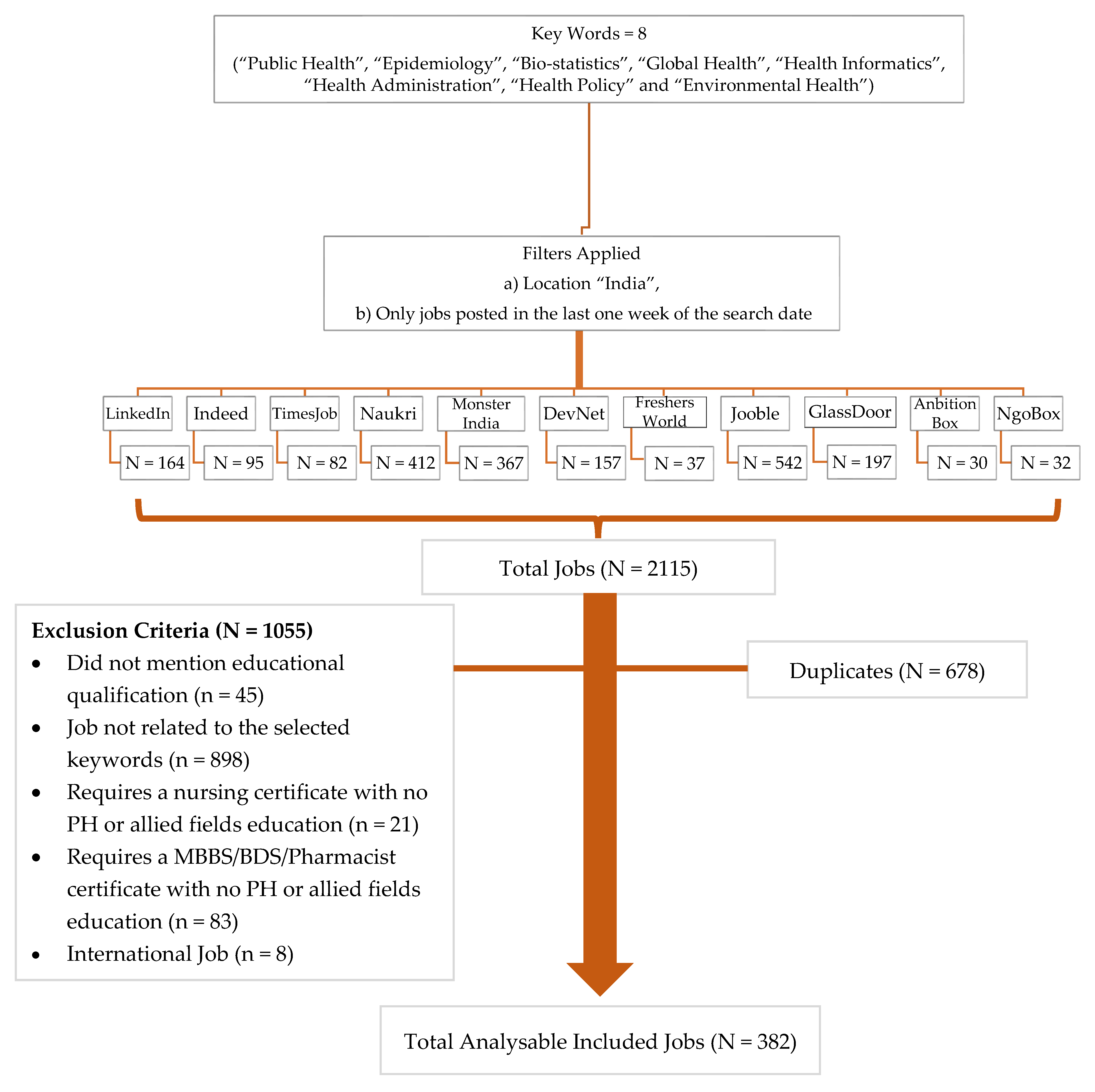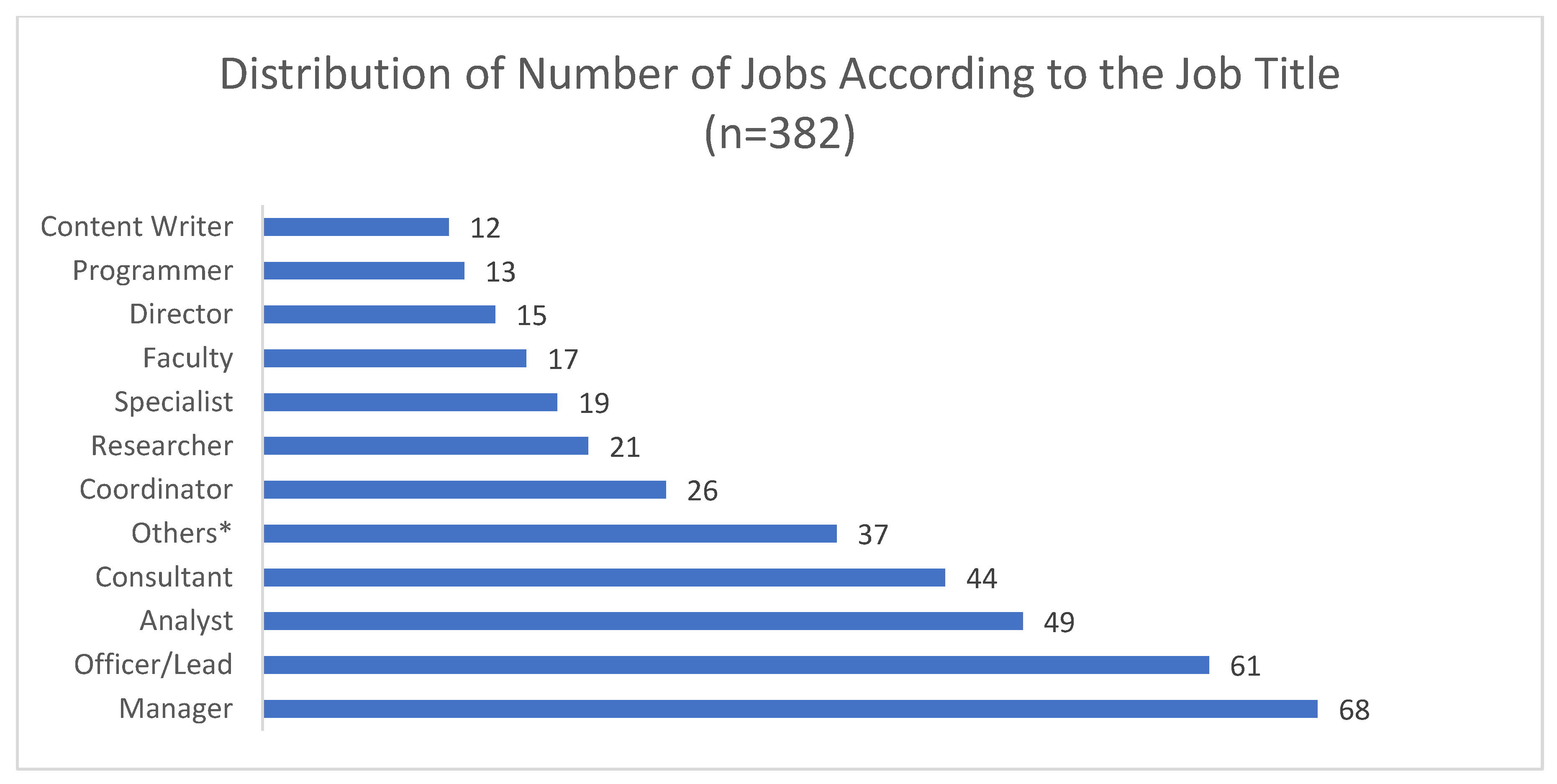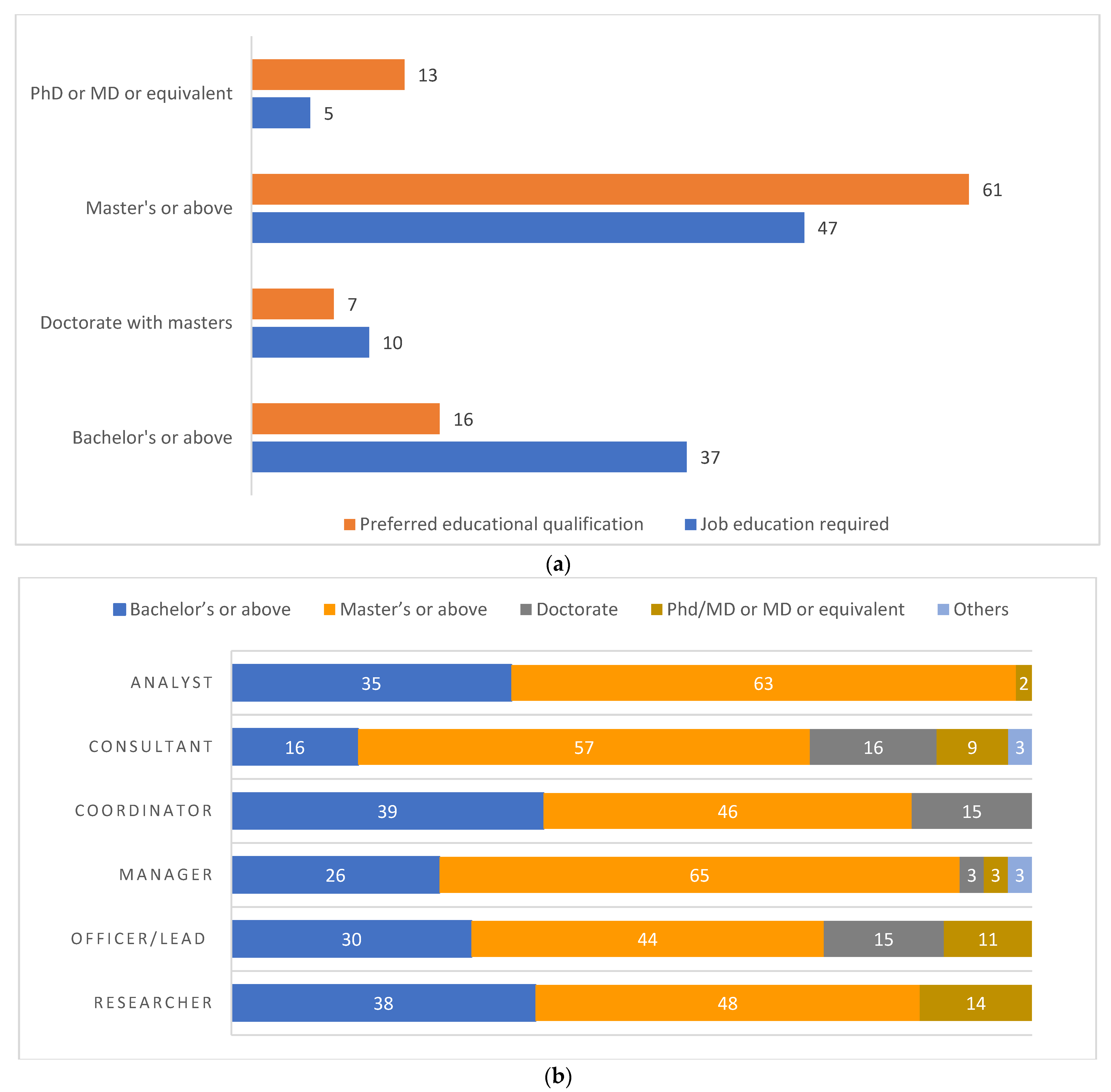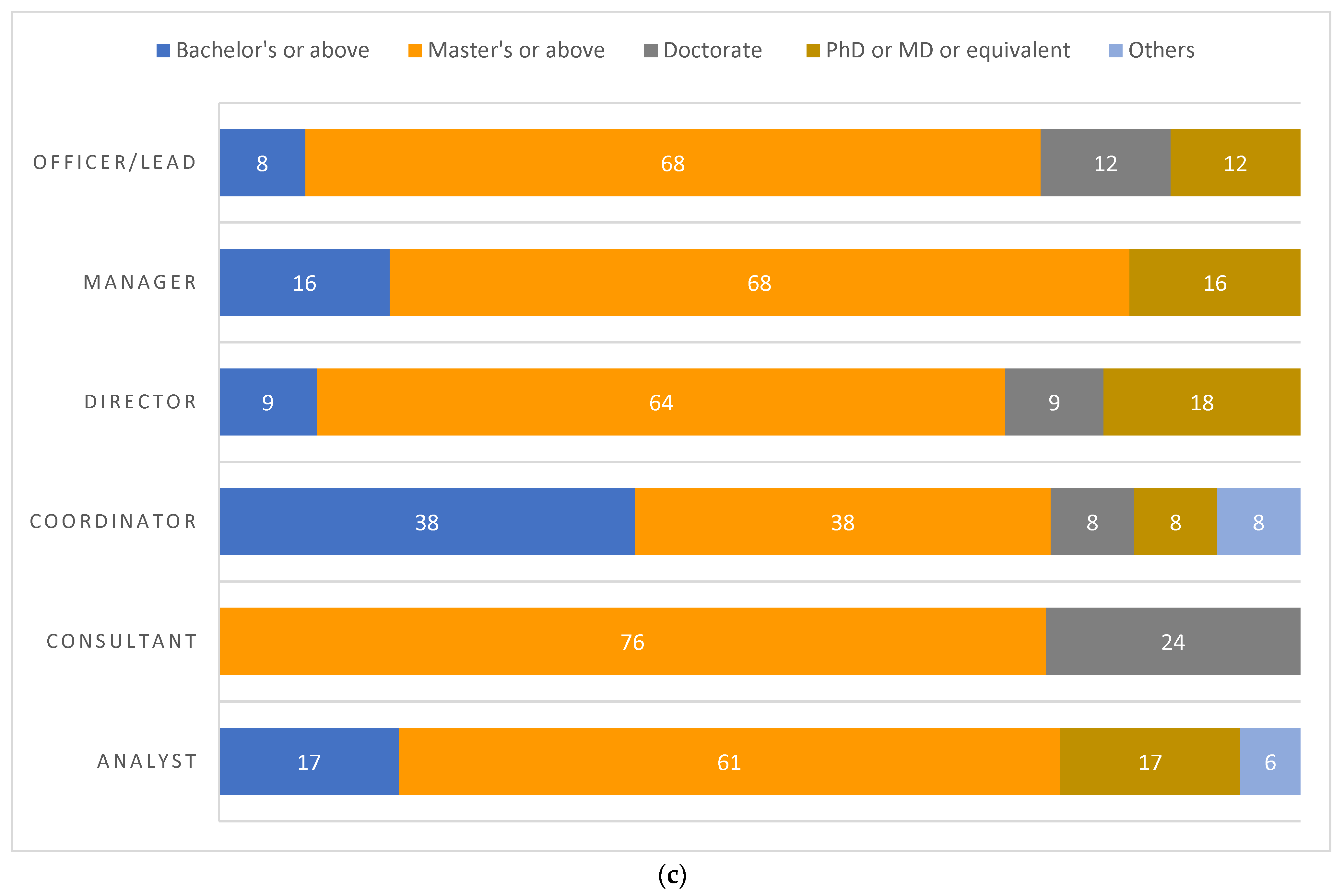Landscape Analysis of Public Health Jobs in India to Develop an Evidence-Based Public Health Curriculum
Abstract
1. Introduction
2. Materials and Methods
2.1. Search Period
2.2. Inclusion and Exclusion Criteria
Definition of Public Health Jobs
2.3. Data Selection
2.4. Data Extraction and Analysis
- Job Title: Data was recorded from the publicly available jobs across various job portals in India. These jobs were further characterized into different categories based on the job title and the job description. The emerged major relevancies were noted and classified according to the meaning they conveyed. Further, the qualitative data collected was coded in order to identify patterns across the data in relation to the title and description. For example:
- Analyst: Job title was classified as an analyst if its main function was to evaluate different health programs, focusing on the analysis of large-scale data reporting projects. Biostatistician, Data analyst, Biostatistician manager, and statistician in the title were classified as analysts.
- Director: Program Director, Academic Director, Deputy Chief of Party, and director word specified in the job title were classified under director. The Director’s role included performing administrative work and developing a team, building and designing programs, services, and initiatives. Responsible for maintaining and improving the efficiency and effectiveness of all areas under his/her direction and control.
- Faculty: Job postings by educational institutes/universities for teaching the students were classified under the faculty category.
- Researcher: The job posting requiring the candidate to devise, formulate, and execute study protocols and disseminate their insights through the publishing of findings were classified as a researcher.
- Manager: Project Manager, Program Officer/Lead, Policy Manager, states operations manager in the title along with the responsibility of project/program management financial, training, strategic planning, operations, or personnel management were classified as Mangers.
- Consultant: Those job postings that demanded candidates to provide expert opinions, analysis, recommendations, and providing strategies to prevent problems and improve performance to organizations or individuals were classified as consultants.
- Organization type: The name and types of the organizations of the available jobs postings were recorded. They were then categorized into (a) Non-Profit Organization, (b) Consulting Organization, (c) Pharmaceutical organization, (d) Contract Research Organization (e) Academia, (f) International Health agency, (g) Government of India (h) Health and Hospital and (i) Others
- Location: The location of the vacancies across different Indian states was also documented.
- Educational Qualification (Required/Preferred): Data were recorded for both required and preferred qualification requirements mentioned in the job posting. Information recorded on the MPH and the allied fields included public health, epidemiology, biostatistics, informatics, nutrition. They were then classified into the following: (a) Bachelors (any) and above, (b) Masters (any) and above, (c) Ph.D. and above, (d) Medicine (Doctorate) plus Masters.
- Work experience: Information was extracted on work experience needed, i.e., required or preferred to apply for the various jobs available.
- Salary: Information on the available salary information gathered across the various job postings.
- Job type: Job postings were screened to record data on the job type including contract, full-time, internship, part-time or temporary.
- Knowledge, competencies, and expertise: Information gathered regarding the knowledge, competencies, and expertise mentioned for the available public health jobs.
- Skills: Information was also recorded to gather information on the type of skills. Descriptive analysis was also performed to determine the most common software skills listed with each job description.
2.5. Statistical Analysis
3. Results
3.1. Identification of Jobs across Job Portals
3.2. General Characteristics of the Job Postings
3.3. General Characteristics of the Job Postings
3.4. Knowledge, Competencies, Behavioural Attributes and Expertise
3.5. Types of Skills Mentioned in Different Job Postings
4. Discussion
5. Conclusions
Supplementary Materials
Author Contributions
Funding
Institutional Review Board Statement
Informed Consent Statement
Data Availability Statement
Conflicts of Interest
References
- Sawleshwarkar, S.; Zodpey, S.P.; Negin, J. Indian Public Health Students’ Perspectives on Global Health Education. Front. Public Health 2021, 8, 614744. [Google Scholar] [CrossRef] [PubMed]
- Tiwari, R.; Negandhi, H.; Zodpey, S. Current status of master of public health programmes in India: A scoping review. WHO South East Asia J. Public Health 2018, 7, 29. [Google Scholar] [CrossRef] [PubMed]
- Ministry of Health and Family Welfare. Model Curriculum Handbook: Masters in Public Health; Ministry of Health and Family Welfare: New Delhi, India, 2017–2018. [Google Scholar]
- Zodpey, S.P.; Sharma, A. Transforming Public Health Education in India through networking and collaborations: Opportunities and challenges. Indian J. Public Health 2013, 57, 155. [Google Scholar] [CrossRef] [PubMed]
- Frenk, J.; Chen, L.; Bhutta, Z.A.; Cohen, J.; Crisp, N.; Evans, T.; Fineberg, H.; Garcia, P.; Ke, Y.; Kelley, P.; et al. Health Professionals for a new century: Transforming education to strengthen health systems in an interdependent world. Lancet 2010, 376, 1923–1958. [Google Scholar] [CrossRef] [PubMed]
- Gebbie, K.; Rosenstock, L.; Hernandez, L.M. (Eds.) Educating Public Health Professionals for the 21st Century. In Who Will Keep the Public Healthy? The National Academic Press and Healthy: Washington, DC, USA, 2003. [Google Scholar] [CrossRef]
- Bhore, J. Report of the Health Survey and Development Committee; Government of India: New Delhi, India, 1946; Volume 1, pp. 158–175. [Google Scholar]
- WHO. The World Health Report; WHO: Geneva, Switzerland, 2006; pp. 212–213. [Google Scholar]
- Josefsson, K.A.; Krettek, A. Staying true to the core of Public Health Science in times of change. Front. Public Health 2021, 9, 653797. [Google Scholar] [CrossRef] [PubMed]
- World Health Organization. Essential Public Health Functions, Health Systems and Health Security: Developing Conceptual Clarity and a WHO Roadmap for Action; WHO: Geneva, Switzerland, 2018. [Google Scholar]
- Bhandari, S.; Wahl, B.; Bennett, S.; Engineer, C.; Pandey, P.; Peters, D. Identifying core competencies for practicing public health professionals: Results from a Delphi exercise in Uttar Pradesh, India. BMC Public Health 2020, 20, 1737. [Google Scholar] [CrossRef] [PubMed]
- Sharma, K.; Zodpey, S.; Negandhi, H.; Morgan, A. Contextualizing Indian Masters of Public Health (MPH) programs–Challenges and the way forward. South-East Asian J. Med. Educ. 2014, 8, 21. [Google Scholar] [CrossRef]
- Equator Network. Search for Reporting Guidelines. Available online: https://www.equator-network.org/reporting-guidelines/strobe/ (accessed on 17 November 2022).
- Rotem, A.; Walters, J.; Dewdney, J. The public health workforce education and training study. Aust. J. Public Health 1995, 19, 437–438. [Google Scholar] [CrossRef] [PubMed]
- National Health Portal of India. Allied Health Care Professions. Available online: https://www.nhp.gov.in/allied-health-care-professions_pg (accessed on 26 August 2022).
- Dahal, S.; Tiwari, R.; Zodpey, S. Public Health Job Opportunities in India. J. Health Manag. 2015, 17, 195–203. [Google Scholar] [CrossRef]
- Regan, S.; MacDonald, M.; Allan, D.; Martin, C.; Peroff-Johnston, N. Public health human resources: A comparative analysis of policy documents in two Canadian provinces. Hum. Resour. Health 2014, 12, 13. [Google Scholar] [CrossRef] [PubMed]
- Cole, K.; Sim, F.; Hogan, H. The Evolution of Public Health Education and Training in the United Kingdom. Public Health Rev. 2011, 33, 87–104. [Google Scholar] [CrossRef]
- World Health Organization. Roadmap to Professionalizing the Public Health Workforce in the European Region; WHO Regional Office for Europe: Copenhagen, Denmark, 2022. [Google Scholar]
- National Academies of Sciences, Engineering, and Medicine. The Future of the Public’s Health in the 21st Century; The National Academies Press: Washington, DC, USA, 2003. [Google Scholar] [CrossRef]
- Lyles, C.; Lunn, M.; Obedin-Maliver, J.; Bibbins-Domingo, K. The new era of precision population health: Insights for the All of Us Research Program and beyond. J. Transl. Med. 2018, 16, 211. [Google Scholar] [CrossRef] [PubMed]
- Dinov, I. Modernizing the Methods and Analytics Curricula for Health Science Doctoral Programs. Front. Public Health 2020, 8, 22. [Google Scholar] [CrossRef] [PubMed]
- Centers for Disease Control and Prevention. CDC—10 Essential Public Health Services. Available online: https://www.cdc.gov/publichealthgateway/publichealthservices/essentialhealthservices.html (accessed on 17 November 2022).
- Joshi, A.; Bruce, I.; Amadi, C.; Amatya, J. Developing Evidence-based Population Health Informatics curriculum: Integrating competency based model and job analysis. Online J. Public Health Inform. 2021, 13, e10. [Google Scholar] [CrossRef] [PubMed]
- Ghaffar, A.; Rashid, S.; Wanyenze, R.; Hyder, A. Public health education post-COVID-19: A proposal for critical revisions. BMJ Glob. Health 2021, 6, e005669. [Google Scholar] [CrossRef] [PubMed]
- Dahal, S.; Sharma, A.; Zodpey, S. Mapping of Public Health Jobs in India—Where Can the Public Health Graduates Be Employed? J. Health Manag. 2018, 20, 73–83. [Google Scholar] [CrossRef]





| Skills/Values/Competency | Skills, Values, and Competencies Mentioned in the MPH Curriculum Are Expected to Be Demonstrated/Developed by the Students. |
|---|---|
| Skills |
|
| Values |
|
| Competencies | |
| Competency 1: Apply the course learning to the public health system and its challenges: |
|
| Competency 2: Develop, implement and evaluate key public health policies: |
|
| Competency 3: Develop and demonstrate competency in managing health systems at different levels: |
|
| Competency 4: Develop competency in research: |
|
| Job Portal | Date of Search (Website) | Biostatistics | Environmental Health | Epidemiology | Global Health | Health Administration | Health Informatics | Health Policy | Public Health | Total Number of Jobs |
|---|---|---|---|---|---|---|---|---|---|---|
| Portal 1 | 25 June 2021 | 2 | 0 | 1 | 0 | 0 | 0 | 0 | 5 | 8 |
| Portal 2 | 26 June 2021 | 0 | 0 | 0 | 0 | 2 | 0 | 0 | 4 | 6 |
| Portal 3 | 21 June 2021 | 6 | 5 | 1 | 3 | 1 | 5 | 1 | 17 | 39 |
| Portal 4 | 14 June 2021 | 3 | 3 | 0 | 3 | 1 | 1 | 0 | 19 | 30 |
| Portal 5 | 26 June 2021 | 15 | 6 | 16 | 8 | 6 | 9 | 6 | 9 | 75 |
| Portal 6 | 15 June 2021 | 16 | 2 | 8 | 4 | 1 | 1 | 0 | 25 | 57 |
| Portal 7 | 21 June 2021 | 2 | 2 | 1 | 0 | 0 | 4 | 0 | 1 | 10 |
| Portal 8 | 25 June 2021 | 5 | 1 | 3 | 7 | 0 | 0 | 0 | 13 | 29 |
| Portal 9 | 23 June 2021 | 8 | 1 | 7 | 0 | 1 | 0 | 0 | 9 | 26 |
| Portal 10 | 28 June 2021 | 1 | 1 | 6 | 13 | 1 | 0 | 3 | 69 | 94 |
| Portal 11 | 7 July 2021 | 8 | 8 | |||||||
| Parameter | Attributes | n (%) |
|---|---|---|
| Location | Delhi | 98 (24) |
| Karnataka | 69 (17) | |
| Maharashtra | 49 (12) | |
| Telangana | 26 (6) | |
| Haryana | 25 (6) | |
| Tamil Nadu | 24 (6) | |
| Uttar Pradesh | 20 (5) | |
| Hiring Organization Type | Non Profit | 132 (37) |
| Consulting | 56 (16) | |
| Pharma | 44 (12) | |
| Academia | 38 (11) | |
| Contract Research Organization (CRO) | 34 (9) | |
| International Health agency | 23 (6) | |
| Government of India | 16 (4) | |
| Health and Hospital | 10 (3) | |
| Others 1 | 6 (2) | |
| Salary | Not Mentioned | 327 (86) |
| Mentioned | 61 (16) | |
| Volunteer | 1 (0) |
| Knowledge/Competencies and Expertise | n (%) | |
|---|---|---|
| A. Knowledge and Understanding of organisation | IT applications | 134 (34) |
| Others 1 | 49 (13) | |
| Medical and Clinical | 31 (8) | |
| Management and planning | 31 (8) | |
| Pharmaceutical (drug development and products, regulatory affairs) | 14 (4) | |
| Health Informatics | 13 (3) | |
| Understanding of organisational processes | 12 (3) | |
| A1. Knowledge and skillset of Public Health Allied Fields | Others 2 | 54 (86) |
| General Public health | 29 (7) | |
| Health system & Gov. organisations, policies, schemes and programs, and governance | 17 (4) | |
| MNCAH & Family Planning | 12 (3) | |
| B. Understanding of Research | Data analysis and Statistical approaches | 116 (64) |
| Clinical Research and Trials | 42 (23) | |
| Research principles and guidelines | 23 (13) | |
| C. Behavioural/Personal Attributes | Effective Communication and influence | 193 (15) |
| Team-worker (multicultural & multidisciplinary team) | 127 (10) | |
| Strong relations with stakeholders and individuals | 124 (10) | |
| Strategic, creative, attention to detail, and critical thinker | 102 (8) | |
| Self-starter and independent worker (self-motivated) | 99 (8) | |
| Adaptability (meeting deadlines, prioritizing) | 97 (8) | |
| Problem Solver | 77 (6) | |
| Leadership (entrepreneur mind-set) | 70 (5) | |
| Multi-tasker | 65 (5) | |
| Interpret and produce results (present data and reports) | 62 (5) | |
| Organiser | 47 (4) | |
| Decision maker | 45 (4) | |
| Proactive (propose new ideas & initiatives, meeting objectives, performance oriented) | 40 (3) | |
| Training and institutional capacity building | 32 (2) | |
| Innovation (innovative mind-set) & Organisational learning | 30 (2) | |
| Others 3 | 27 (2) | |
| Work ethics (accountability, empathy, confidentiality) | 25 (2) | |
| Creating empowering and motivating environment | 19 (1) | |
| Job Category | Skills | n (%) |
|---|---|---|
| Software skills | Others 1 | 53 (28) |
| SAS | 28 (15) | |
| R software | 25 (14) | |
| SQL | 23 (13) | |
| Python | 22 (12) | |
| SPSS | 21 (11) | |
| STATA | 12 (7) | |
| Communication skills | Spoken | 237 (45) |
| Writing | 236 (44) | |
| Presentation Skills/Creative skills | 54 (10) | |
| Others 2 | 4 (1) | |
| Technical skills | MS Office | 133 (70) |
| Data Anaysis Software& data visulization tools | 37 (20) | |
| Cloud system (AVS) | 11 (6) | |
| Others 3 | 8 (4) | |
| Others skills | Management Skills | 149 (28) |
| Analytical Skills | 138 (26) | |
| Interpersonal Skills/Collaboration skills | 118 (22) | |
| Technical Writing Skills | 63 (12) | |
| Scientific Writing | 25 (5) | |
| Clinical skills | 20 (4) | |
| Others 4 | 19 (3) | |
| Language | English | 116 (54) |
| Hindi Language | 57 (26) | |
| Regional Language | 40 (19) | |
| Others 5 | 3 (1) |
Publisher’s Note: MDPI stays neutral with regard to jurisdictional claims in published maps and institutional affiliations. |
© 2022 by the authors. Licensee MDPI, Basel, Switzerland. This article is an open access article distributed under the terms and conditions of the Creative Commons Attribution (CC BY) license (https://creativecommons.org/licenses/by/4.0/).
Share and Cite
Joshi, A.; Bhatt, A.; Kaur, M.; Grover, A. Landscape Analysis of Public Health Jobs in India to Develop an Evidence-Based Public Health Curriculum. Int. J. Environ. Res. Public Health 2022, 19, 15724. https://doi.org/10.3390/ijerph192315724
Joshi A, Bhatt A, Kaur M, Grover A. Landscape Analysis of Public Health Jobs in India to Develop an Evidence-Based Public Health Curriculum. International Journal of Environmental Research and Public Health. 2022; 19(23):15724. https://doi.org/10.3390/ijerph192315724
Chicago/Turabian StyleJoshi, Ashish, Ashruti Bhatt, Mahima Kaur, and Ashoo Grover. 2022. "Landscape Analysis of Public Health Jobs in India to Develop an Evidence-Based Public Health Curriculum" International Journal of Environmental Research and Public Health 19, no. 23: 15724. https://doi.org/10.3390/ijerph192315724
APA StyleJoshi, A., Bhatt, A., Kaur, M., & Grover, A. (2022). Landscape Analysis of Public Health Jobs in India to Develop an Evidence-Based Public Health Curriculum. International Journal of Environmental Research and Public Health, 19(23), 15724. https://doi.org/10.3390/ijerph192315724





